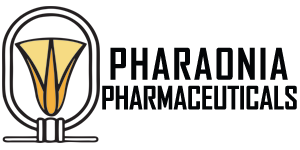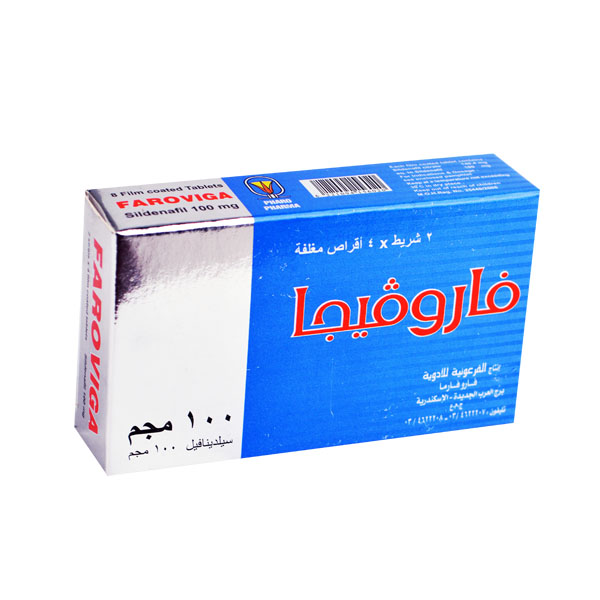Description
Clinical particulars
Therapeutic Indication
Faroviga is indicated in adult men with erectile dysfunction, which is the inability to achieve or maintain a penile erection sufficient for satisfactory sexual performance. In order for Faroviga to be effective, sexual stimulation is required.
Posology and method of administration
Posology
Use in adults
The recommended dose is 50 mg taken as needed approximately one hour before sexual activity. Based on efficacy and tolerability, the dose may be increased to 100 mg or decreased to 25 mg. The maximum recommended dose is 100 mg. The maximum recommended dosing frequency is once per day. If Faroviga is taken wijh food, the onset of activity may be delayed compared to the fasted state.
Special populations
Elderly patients
Dosage adjustment are not required in elderly patients.
Patients with renal impairment
The dosing recommendations described in “Use in adults” apply to patients with mild to moderate renal impairment (creatinine clearance = 30-80 ml/min).
Since sildenafil clearance is reduced in patients with severe renal impairment (creatinine clearance < 30 ml/min) a 25 mg dose should be considered. Based on efficacy and tolerability, the dose may be increased step-wise to 50mg up to 100 mg as necessary.
Patients with hepatic impairment
Since sildenafil clearance is reduced in patients with hepatic impairment (e.g. cirrhosis) a 25 mg dose should be considered. Based on efficacy and tolerability, the dose may be increased step-wise to 50 mg up to 100 mg as necessary.
Paediatric population
Faroviga is not indicated for individuals below 18 years of age.
Use in patients taking other medical products
With the exception of ritonavir for which co-administration with sildenafil is not advised a starting dose of 25mg should be considered in patients receiving concomitant treatment with CYP3A4 inhibitors.
In order to minimise the potential of developing postural hypotension in patients receiving alpha-blocker treatment patients should be stablised on alpha-blocker therapy prior to initiating sildenafil treatment. In addition, initiation of sildenafil at a dose of 25mg should be considered.
Method of administration
For oral use.
Contraindications
Hypersensitivity to the active substance or to any of the excipients.
Consistent with its known effects on the nitric oxide/cyclic guanosine monophosphate (cGMP) pathway, sildenafil was shown to potentiate the hypotensive effects of nitrates, and its co-administration with nitric oxide donors (such as amyl nitrite) or nitrates in any form is therefore contraindicated.
Agents for the treatment of erectile dysfunction, including sildenafil, should not be used in men for whom sexual activity is inadvisable (e.g. patients with severe cardiovascular disorders such as unstable angina or severe cardiac failure).
Faroviga is contraindicated in patients who have loss of vision in one eye because of non-arteritic anterior ischaemic optic neuropathy (NAION), regardless of whether this episode was in connection or not with previous PDE5 inhibitor exposure.
The safety of sildenafil has not been studied in the following sub-groups of patients and its use is therefore contraindicated: severe hepatic impairment, hypotension (blood pressure < 90/50 mmHg), recent history of stroke or myocardial infarction and known hereditary degenerative retinal disorders such as retinitis pigmentosa (a minority of “1′ these patients have genetic disorders of retinal phosphodiesterases).
Special warnings and precautions for use
A medical history and physical examination should be undertaken to diagnose erectile dysfunction and determine potential underlying causes, before pharmacological treatment is considered.
Cardiovascular risk factors
Prior to initiating any treatment for erectile dysfunction. physicians should consider the cardiovascular status of their patients. since there is a degree of cardiac risk associated with sexual activity. Sildenafil has vasodilator properties, resulting in mild and transient decreases in blood pressure. Prior to prescribing sildenafil. physicians should carefully consider whether their patients with certain underlying conditions could be adversely affected by such vasodilatory effects. especially in combination with sexual activity. Patients with increased susceptibility to vasodilators include those with left ventricular outflow obstruction (e.g., aortic stenosis. hypertrophic obstructive cardiomyopathy). or those with the rare syndrome of multiple system atrophy manifesting as severely impaired autonomic control of blood pressure.
Faroviga potentiates the hypotensive effect of nitrates.
Serious cardiovascular events, including myocardial infarction. unstable angina, sudden cardiac death. ventricular arrhythmia, cerebrovascular haemorrhage. transient ischaemic attack. hypertension and hypotension have been reported post-marketing in temporal association with the use of VIAGRA. Most. but not all, of these patients had pre-existing cardiovascular risk factors. Many events were reported to occur during or shortly after sexual intercourse and a few were reported to occur shortly after the use of VIAGRA without sexual activity. It is not possible to determine whether these events are related directly to these factors or to other factors.
Priapism
Agents for the treatment of erectile dysfunction. including sildenafil, should be used with caution in patients with anatomical deformation of the penis (such as angulation. cavernosal fibrosis or Peyronie’s disease), or in patients who have conditions which may predispose them to priapism (such as sickle cell anaemia. multiple myeloma or leukaemia).
Concomitant use with other treatments for erectile dysfunction
The safety and efficacy of combinations of sildenafil with other treatments for erectile dysfunction have not been studied. Therefore the use of such combinations is not recommended.
Effects on vision
Visual defects and cases of non-arteritic anterior ischaemic optic neuropathy have been reported in connection with the intake of sildenafil and other PDE5 inhibitors. The patient should be advised that in the event of any sudden visual defect. he should stop taking Faroviga and consult a physician immediately.
Concomitiant use with ritonavir
Co-administration of sildenafil with ritonavir is not advised. Concomitiant use with alpha-blockers
Caution is advised when sildenafil is administered to patients taking an alpha-blocker. as the co-administration may lead to symptomatic hypotension in a few susceptible individuals. This is most likely to occur within 4 hours post sildenafil dosing. In order to minimise the potential for developing postural hypotension, patients should be hemodynamically stable on alpha-blocker therapy prior to initiating sildenafil treatment. Initiation of sildenafil at a dose of 25 mg should be considered. In addition, physicians should advise patients what to do in the event of postural hypotensive symptoms.
Effect on bleeding
Studies with human platelets indicate that sildenafil potentiates the antiaggregatory effect of sodium nitroprusside in vitro. There is no safety information on the administration of sildenafil to patients with bleeding disorders or active peptic ulceration. Therefore sildenafil should be administered to these patients only after careful benefit-risk assessment.
The film coating of the tablet contains lactose. VIAGRA should not be administered to men with rare hereditary problems of galactose intolerance, Lapp lactase deficiency or glucose-galactose malabsorption.
Women
Faroviga is not indicated for use by women.
Interaction with other medicinal products and other forms of interaction
Effects of other medicinal products on sildenafil
In vitro studies
Sildenafil metabolism is principally mediated by the cytochrome P450 (CYP) isoforms 3A4
(major route) and 2C9 (minor route). Therefore, inhibitors of these isoenzymes may reduce sildenafil clearance.
Population pharmacokinetic analysis of clinical trial data indicated a reduction in sildenafil clearance when co-administered with CYP3A4 inhibitors (such as ketoconazole, erythromycin, cimetidine). Although no increased incidence of adverse events was observed in these patients, when sildenafil is administered concomitantly with CYP3A4 inhibitors, a starting dose of 25 mg should be considered.
Co-administration of the HIV protease inhibitor ritonavir, which is a highly potent P450 inhibitor, at steady state (500 mg twice daily) with sildenafil (100 mg single dose) resulted in a 300% (4-fold) increase in sildenafil Cmax and a 1,000% (11-fold) increase in sildenafil plasma AUC. At 24 hours, the plasma levels of sildenafil were still approximately 200ng/mL, compared to approximately 5ng/mL when sildenafil was administered alone. This is consistent with ritonavir’s marked effects on a broad range of P450 substrates. Sildenafil had no effect on ritonavir pharmacokinetics. Based on these pharmacokinetic results co-administration of sildenafil with ritonavir is not advised and in any event the maximum dose of sildenafil should under no circumstances exceed 25 mg within 48 hours.
Co-administration of the HIV protease inhibitor saquinavir, a CYP3A4 inhibitor, at steady state (1200 mg three times a day) with sildenafil (100 mg single dose) resulted in a 140% increase in sildenafil Cmax and a 210% increase in sildenafil AUC. Sildenafil had no effect on saquinavir pharmacokinetics. Stronger CYP3A4 inhibitors such as ketoconazole and itraconazole would be expected to have greater effects.
When a single 100 mg dose of sildenafil was administered with erythromycin, a specific CYP3A4 inhibitor, at steady state (500 mg twice daily for 5 days), there was a 182% increase in sildenafil systemic exposure (AUC).
Grapefruit juice is a weak inhibitor of CYP3A4 gut wall metabolism and may give rise to modest increases in plasma levels of sildenafil.
Although specific interaction studies were not conducted for all medicinal products, population pharmacokinetic analysis showed no effect of concomitant treatment on sildenafil pharmacokinetics when grouped as CYP2C9 inhibitors (such as tolbutamide, warfarin, phenytoin), CYP206 inhibitors (such as selective serotonin reuptake inhibitors, tricyclic antidepressants), thiazide and related diuretics, loop and potassium sparing diuretics, angiotensin converting enzyme inhibitors, calcium channel blockers, beta-adrenoreceptor antagonists or inducers of CYP450 metabolism (such as rifampicin, barbiturates).
Nicorandil is a hybrid of potassium channel activator and nitrate. Due to the nitrate component it has the potential to result in a serious interaction with sildenafil.
Effects of sildenafil on other medicinal products
In vitro studies
Sildenafil is a weak inhibitor of the cytochrome P450 isoforms 1A2, 2C9, 2C19, 206, 2E1 and 3A4 (ICso >150 ~M). Given sildenafil peak plasma concentrations of approximately 1 ~M after recommended doses, it is unlikely that Faroviga will alter the clearance of substrates of these isoenzymes.
There are no data on the interaction of sildenafil and non-specific phosphodiesterase inhibitors such as theophylline or dipyridamole.
In vivo studies
Consistent with its known effects on the nitric oxide/cGMP pathway. sildenafil was shown to potentiate the hypotensive effects of nitrates, and its co-administration with nitric oxide donors or nitrates in any form is therefore contraindicated.
Concomitant administration of sildenafil to patients taking alpha-blocker therapy may lead to symptomatic hypotension in a few susceptible individuals. This is most likely to occur within 4 hours post sildenafil dosing. In three specific drug-drug interaction studies, the alpha-blocker doxazosin (4 mg and 8 mg) and sildenafil (25 mg, 50 mg, or 100 mg) were administered simultaneously to patients with benign prostatic hyperplasia (BPH) stabilized on doxazosin therapy. In these study populations, mean additional reductions of supine blood pressure of 7/7 mmHg, 9/5 mmHg, and 8/4 mmHg, and mean additional reductions of standing blood pressure of 6/6 mmHg, 11/4 mmHg, and 4/5 mmHg, respectively, were observed. When sildenafil and doxazosin were administered simultaneously to patients stabilized on doxazosin therapy, there were infrequent reports of patients who experienced symptomatic postural hypotension. These reports included dizziness and light-headedness, but not syncope.
No significant interactions were shown when sildenafil (50 mg) was co-administered with tolbutamide (250 mg) or warfarin (40 mg), both of which are metabolised by CYP2C9.
Sildenafil (50 mg) did not potentiate the increase in bleeding time caused by acetyl salicylic acid (150 mg).
Sildenafil (50 mg) did not potentiate the hypotensive effects of alcohol in healthy volunteers with mean maximum blood alcohol levels of 80 mg/dl.
Pooling of the following classes of antihypertensive medication; diuretics, beta-blockers, ACE inhibitors, angiotensin II antagonists, antihypertensive medicinal products (vasodilator and centrally-acting). adrenergic neurone blockers, calcium channel blockers and alpha-adrenoceptor blockers, showed no difference in the side effect profile in patients taking sildenafil compared to placebo treatment. In a specific interaction study, where sildenafil (100 mg) was co-administered with amlodipine in hypertensive patients, there was an additional reduction on supine systolic blood pressure of 8 mmHg. The corresponding additional reduction in supine diastolic blood pressure was 7 mmHg. These additional blood pressure reductions were of a similar magnitude to those seen when sildenafil was administered alone to healthy volunteers.
Sildenafil (100 mg) did not affect the steady state pharmacokinetics of the HIV protease inhibitors, saquinavir and ritonavir, both of which are CYP3A4 substrates.
Fertility, pregnancy and lactation
Faroviga is not indicated for use by women.
There are no adequate and well-controlled studies in pregnant or breast-feeding women.
No relevant adverse effects were found in reproduction studies in rats and rabbits following oral administration of sildenafil.
There was no effect on sperm mobility or morphology after single 100 mg oral doses of sidenafil in healthy volunteers.
Effects on ability to drive and use machines
No studies on the effects on the ability to drive and use machines have been performed.
As dizziness and altered vision were reported in clinical trials with sildenafil, patients should be aware of how they react to VIAGRA, before driving or operating machinery.
Undersirable effects
Tabulated list of adverse reactions
In the table below all medically important adverse reactions, which occurred in clinical trials at an incidence greater than placebo are listed by system organ class and frequency (very common (≥1/10). common (≥1/100 to <1/10), uncommon (≥1/1,000 to <1/100), rare (≥1/10,000 to, 1/1,000).
In addition, the frequency of medically important adverse reactions reported from post-marketing experience is included as not known.
Within each frequency grouping, undesirable effects are presented in order of decreasing seriousness.
Table 1: Medically important adverse reactions reported at an incidence greater than placebo in controlled clinical studies and medically important adverse reactions reported through post-marketing surveillance
| Adverse Reaction | System Organ Class | |||
| Immune system disorders | ||||
| Hypersensitivity reactions | Rare | |||
| Nervous system disorders | ||||
| Headache | Very common | |||
| Dizziness | Common | |||
| Somnolence, Hypoaesthesia | Uncommon | |||
| Cerebrovascular accident, Syncope | Rare | |||
| Transient ischaemic attack, Seizure, Seizure recurrence | Not known | |||
| Eye disorders | ||||
| Visual disorders, Visual colour distortion | Common | |||
| Conjunctival disorders, Eye disorders, Lacrimation disorders, Other eye disorders | Uncommon | |||
| Non-arteritic anterior ischaemic optic neuropathy (NAION), Retinal vascular occlusion, Visual field defect. | Not known | |||
| Ear and labyrinth disorders | ||||
| Vertigo, Tinnitus | Uncommon | |||
| Deafness | Rare | |||
| Cardiac disorders | ||||
| Palpitations, Tachycardia | Uncommon | |||
| Myocardial infarction, Atrial fibrillation | Rare | |||
| Ventricular arrhythmia, Unstable angina, Sudden cardiac death | Unknown | |||
| Vascular disorders | ||||
| Flushing | Common | |||
| Hypertension, Hypotension | Rare | |||
| Respiratory, thoracic and mediastinal disorders | ||||
| Nasal congestion | Common | |||
| Epistaxis | Rare | |||
| Gastrointestinal disorders | ||||
| Vomiting, Nausea, Dry mouth | Common | |||
| Uncommon | Dyspepsia | |||
| Skin, subcutaneous and soft tissue disorders | ||||
| Uncommon | Skin rash | |||
| Not Known | Stevens Johnson Syndrome (SJS). Toxic Epidermal Necrolysis (TEN) | |||
| Musculoskeletal and connective tissue disorders
|
||||
| Myalgia | Uncommon | |||
| Renal and urinary disorders | ||||
| Haematuria | Uncommon | |||
| Reproductive system and breast disorders | ||||
| Haematospermia, Penile haemorrhage | Uncommon | |||
| Priapism, Prolonged erection | Not known | |||
| General disorders and administration site conditions | ||||
| Chest pain, Fatigue | Uncommon | |||
| Investigations | ||||
| Heart rate increased | Uncommon | |||
Overdose
In single dose volunteer studies of doses up to 800 mg, adverse reactions were similar to those seen at lower doses, but the incidence rates and severities were increased. Doses of 200 mg did not result in increased efficacy but the incidence of adverse reactions (headache, flushing, dizziness, dyspepsia, nasal congestion, altered vision) was increased.
In cases of overdose, standard supportive measures should be adopted as required. Renal dialysis is not expected to accelerate clearance as sildenafil is highly bound to plasma proteins and not eliminated in the urine.
Pharmacological properties
Pharmacodynamic Properties
Pharmacotherapeutic group: Urologicals; Drugs used in erectile dysfunction.
Mechanism of action
Sildenafil is an oral therapy for erectile dysfunction. In the natural setting, i.e. with sexual stimulation, it restores impaired erectile function by increasing blood flow to the penis.
The physiological mechanism responsible for erection of the penis involves the release of nitric oxide (NO) in the corpus cavernosum during sexual stimulation. Nitric oxide then activates the enzyme guanylate cyclase, which results in increased levels of cyclic guanosine monophosphate (cGMP), producing smooth muscle relaxation in the corpus cavernosum and allowing inflow of blood.
Sildenafil is a potent and selective inhibitor of cGMP specific phosphodiesterase type 5 (PDE5) in the corpus cavernosum, where PDE5 is responsible for degradation of cGMP. Sildenafil has a peripheral site of action on erections. Sildenafil has no direct relaxant effect on isolated human corpus cavernosum but potently enhances the relaxant effect of NO on this tissue. When the NO/cGMP pathway is activated, as occurs with sexual stimulation, inhibition of PDE5 by sildenafil results in increased corpus cavernosum levels of cGMP. Therefore sexual stimulation is required in order for sildenafil to produce its intended beneficial pharmacological effects.
Pharmacodynamic effects
Studies in vitro have shown that sildenafil is selective for PDE5, which is involved in the erection process. Its effect is more potent on PDE5 than on other known phosphodiesterases. There is a 10-fold selectivity over PDE6 which is involved in the phototransduction pathway in the retina. At maximum recommended doses, there is an 80-fold selectivity over PDE1, and over 700-fold over PDE 2, 3, 4, 7, 8, 9, 10 and 11. In particular, sildenafil has greater than 4,000-fold selectivity for PDE5 over PDE3, the cAMP-specific phosphodiesterase isoform involved in the control of cardiac contractility.
Pharmacokinetic Properties
Apsorption
Sildenafil is rapidly absorbed. Maximum observed plasma concentrations are reached within 30 to 120 minutes (median 60 minutes) of oral dosing in the fasted state. The mean absolute oral bioavailability is 41% (range 25-63%). After oral dosing of sildenafil AUC and Cmax increase in proportion with dose over the recommended dose range (25-100 mg).
When sildenafil is taken with food, the rate of absorption is reduced with a mean delay in tmax of 60 minutes and a mean reduction in Cmax of 29%.
Distribution
The mean steady state volume of distribution (Vd) for sildenafil is 105 I, indicating distribution into the tissues. After a single oral dose of 100 mg, the mean maximum total plasma concentration of sildenafil is approximately 440 ng/mL (CV 40%). Since sildenafil (and its major circulating N-desmethyl metabolite) is 96% bound to plasma proteins, this results in the mean maximum free plasma concentration for sildenafil of 18 ng/mL (38 nM). Protein binding is independent of total drug concentrations.
In healthy volunteers receiving sildenafil (100 mg single dose), less than 0.0002% (average 188 ng) of the administered dose was present in ejaculate 90 minutes after dosing.
Biotransformation
Sildenafil is cleared predominantly by the CYP3A4 (major route) and CYP2C9 (minor route) hepatic microsomal isoenzymes. The major circulating metabolite results from N-demethylation of sildenafil. This metabolite has a phosphodiesterase selectivity profile similar to sildenafil and an in vitro potency for PDE5 approximately 50% that of the parent drug. Plasma concentrations of this metabolite are approximately 40% of those seen for sildenafil. The N-desmethyl metabolite is further metabolised, with a terminal half life of approximately 4 h.
Elimination
The total body clearance of sildenafil is 41 L/h with a resultant terminal phase half life of 3-5 h. After either oral or intravenous administration, sildenafil is excreted as metabolites predominantly in the faeces (approximately 80% of administered oral dose) and to a lesser extent in the urine (approximately 13% of administered oral dose).
Pharmacokinetics in special patient groups
Elderly
Healthy elderly volunteers (65 years or over) had a reduced clearance of sildenafil, resulting in approximately 90% higher plasma concentrations of sildenafil and the active N-desmethyl metabolite compared to those seen in healthy younger volunteers (18-45 years). Due to age-differences in plasma protein binding, the corresponding increase in free sildenafil plasma concentration was approximately 40%.
Renal insufficiency
In volunteers with mild to moderate renal impairment (creatinine clearance = 30-80 ml/min), the pharmacokinetics of sildenafil were not altered after receiving a 50 mg single oral dose. The mean AUC and Cmax of the N-desmethyl metabolite increased 126% and 73% respectively, compared to age-matched volunteers with no renal impairment. However, due to high inter-subject variability, these differences were not statistically significant. In volunteers with severe renal impairment (creatinine clearance < 30 ml/min), sildenafil clearance was reduced, resulting in mean increases in AUC and Cmax of 100% and 88% respectively compared to age-matched volunteers with no renal impairment. In addition, N-desmethyl metabolite AUC and Cmax values were significantly increased 79% and 200% respectively.
Hepatic insufficiency
In volunteers with mild to moderate hepatic cirrhosis sildenafil clearance was reduced, resulting in increases in AUC (84%) and Cmax (47%) compared to age-matched volunteers with no hepatic impairment. The pharmacokinetics of sildenafil in patients with severely impaired hepatic function have not been studied.
Packing:
Faroviga 100:
A carton box containing 4 film coated tablets in one transparent PVC/Al strip.
A carton box containing 8 film coated tablets in 2 transparent PVC/Al strips.
Faroviga 25:
A carton box containing 10 film coated tablets in one transparent PVC/Al strip.
Storage:
Keep at a temperature not exceeding 30°C, in dry place.
Keep out of reach of children.







Reviews
There are no reviews yet.